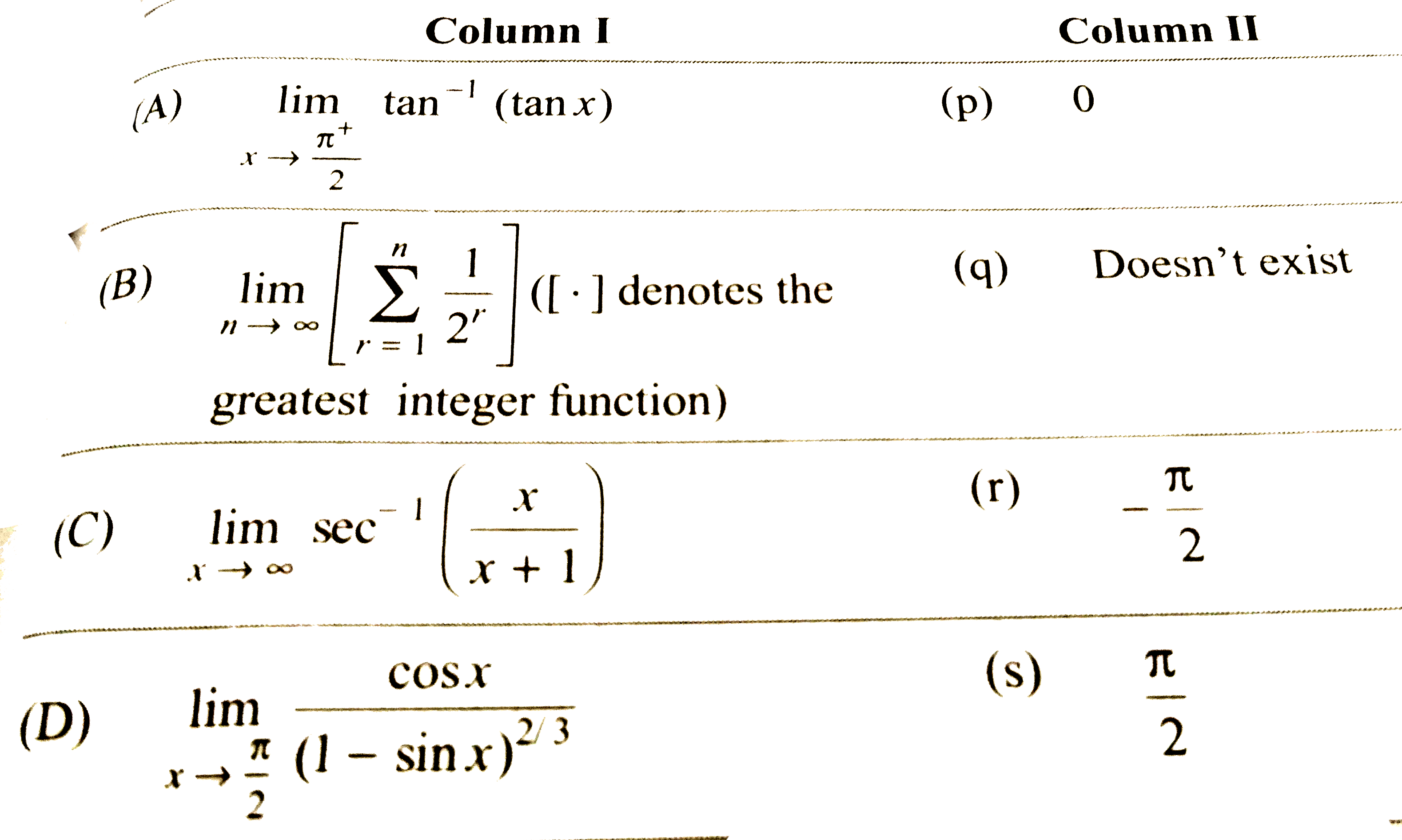Identify the correct statement.
a. limx→∞[n∑r=112r]=1
b. If f(x)=(x−1){x}, where [.] and {.} denotes greatest integer function and fractional part of x respectively, the limit of f(x) does not exist at x=1
c. limx→0+[tanxx]=1
d. [limx→0+tanxx]=1Solution in Punjabi
limx→∞[n∑r=112r]=1
If f(x)=(x−1){x}, where [.] and {.} denotes greatest integer function and fractional part of x respectively, the limit of f(x) does not exist at x=1
limx→0+[tanxx]=1
[limx→0+tanxx]=1
The correct Answer is:C, D
Step by step video & image solution for Identify the correct statement. a. lim_(xtooo)[sum_(r=1)^(n)1/(2^(r))]=1b. If f(x)=(x-1){x}, where [.] and {.} denotes greatest integer function and fractional part of x respectively, the limit of f(x) does not exist at x=1c. lim_(xto0^(+))[(tanx)/x]=1d. [lim_(xto0^(+))(tanx)/x]=1 by Maths experts to help you in doubts & scoring excellent marks in Class 12 exams.
Updated on:21/07/2023Topper's Solved these Questions
- LIMITSBOOK - ARIHANT MATHSCHAPTER - LIMITSEXERCISE - Exercise (Passage Based Questions)
10 Videos
- LIMITSBOOK - ARIHANT MATHSCHAPTER - LIMITSEXERCISE - Exercise (Matching Type Questions)
3 Videos
- LIMITSBOOK - ARIHANT MATHSCHAPTER - LIMITSEXERCISE - Exercise (Single Option Correct Type Questions)
38 Videos
- INVERSE TRIGONOMETRIC FUNCTIONSBOOK - ARIHANT MATHSCHAPTER - INVERSE TRIGONOMETRIC FUNCTIONSEXERCISE - Exercise (Questions Asked In Previous 13 Years Exam)
8 Videos
- LOGARITHM AND THEIR PROPERTIESBOOK - ARIHANT MATHSCHAPTER - LOGARITHM AND THEIR PROPERTIESEXERCISE - Exercise (Questions Asked In Previous 13 Years Exam)
4 Videos
Similar Questions
If limx→af(x)=1 and limx→ag(x)=∞ then limx→a{f(x)}g(x)=elimx→a(f(x)−1)g(x)
limx→0(sinxx)sinxx−sinx is equal to
View SolutionMatch the statements of Column I with values of Column II.

View Solutionlimx→0sin(πcos2(tan(sinx)))x2 is equal to
View SolutionIf α=3sin−1(611andβ=3cos−1(49), where the inverse trigonometric functions take only the principal values, then the correct options (s) is (are)
View SolutionIn Which quadrant Point (−2,−3) will be lie.
View SolutionStatement - 1: The function f(x) = {x}, where {.} denotes the fractional part function is discontinuous a x = 1 Statement -2: lim_(x->1^+) f(x)!= lim_(x->1^+) f(x)
View SolutionIf f(x)=tanxx, then find limx→0([f(x)]+x2)1[f(x)], where [.] and {.} denotes greatest integer and fractional part function respectively.
View Solutionlimx→0+∑2n+1r=1[xr]+(n+1)1+[x]+|x|+2x, where n∈N and [.] denotes the greatest integer function, equals
View SolutionConsider the function f(x)=a[x]+x−1[x]+x where [.] denotes the greatest integer function.
What is limx→0+f(x) equal to?
View SolutionConsider the function f(x)=a[x]+x−1[x]+x where [.] denotes the greatest integer function.
What is limx→0−(f(x) equal to?
View SolutionSolve (i) limx→0+[tanxx]
(ii) limx→0−[tanxx]
(where [.] denotes greatest integer function)
View SolutionStatement 1: If limx→0{f(x)+sinxx} does not exist then limx→0f(x) does not exist.
Statement 2: limx→0(e1/x−1e1/x+1) does not exist.
View Solutionसीमाओं का मान ज्ञात कीजिए-
limx→0xtanx1−cosx
View Solutionयदि f(x)=ax+bx+1,limx→0f(x)=2 व limx→∞f(x)=1 तो सिद्ध कीजिए कि f(−2)=0
View SolutionIf x is measured in radian
(i) limx→0xsinx=1
(ii) limx→0tanxx=1
View SolutionIf f(x)=tanxx, then find limx→0([f(x)]+x2)1{f(x)}, where [.] and {.} denotes greatest integer and fractional part function respectively.
View Solution
